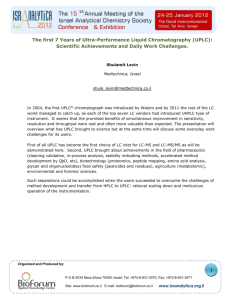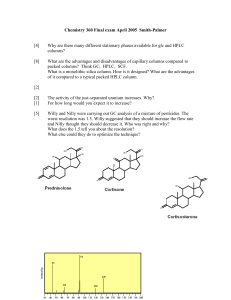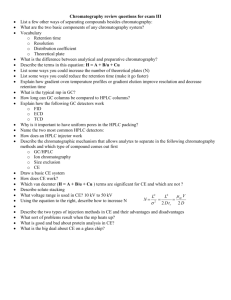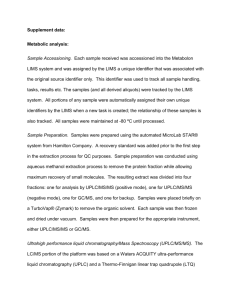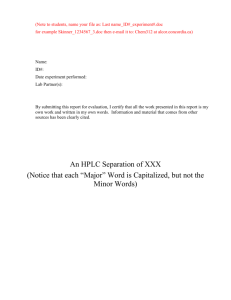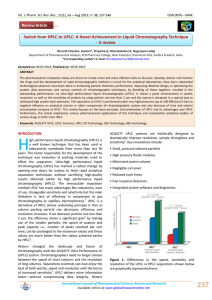Document 13308815
advertisement
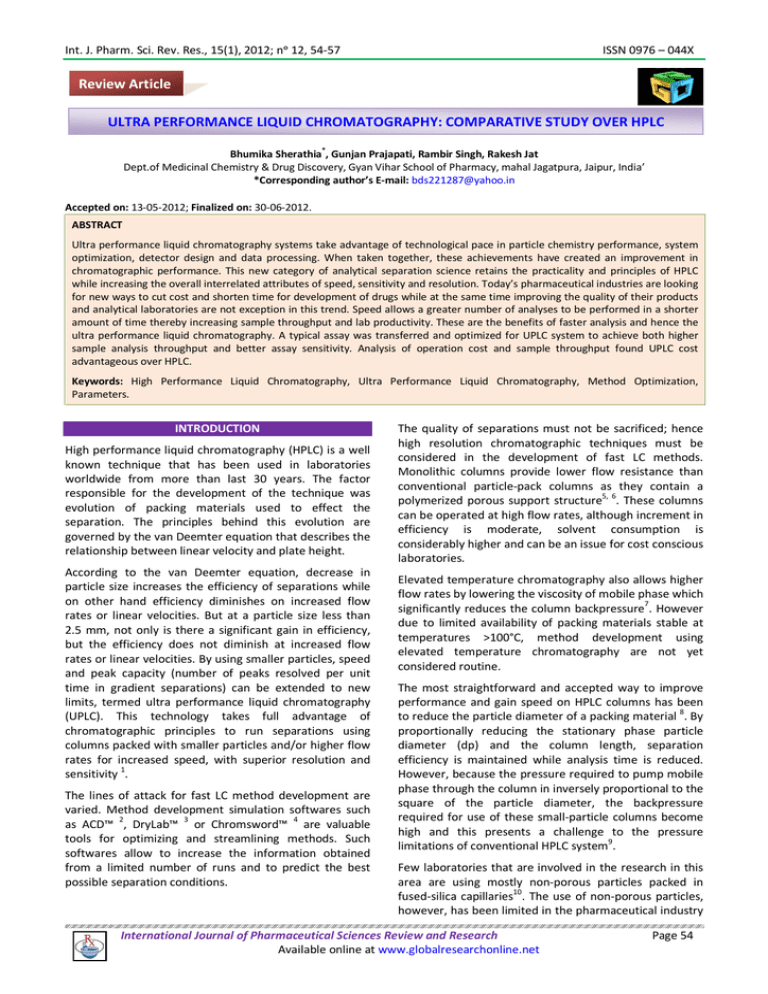
Int. J. Pharm. Sci. Rev. Res., 15(1), 2012; nᵒ 12, 54-57 ISSN 0976 – 044X Review Article ULTRA PERFORMANCE LIQUID CHROMATOGRAPHY: COMPARATIVE STUDY OVER HPLC * Bhumika Sherathia , Gunjan Prajapati, Rambir Singh, Rakesh Jat Dept.of Medicinal Chemistry & Drug Discovery, Gyan Vihar School of Pharmacy, mahal Jagatpura, Jaipur, India’ *Corresponding author’s E-mail: bds221287@yahoo.in Accepted on: 13-05-2012; Finalized on: 30-06-2012. ABSTRACT Ultra performance liquid chromatography systems take advantage of technological pace in particle chemistry performance, system optimization, detector design and data processing. When taken together, these achievements have created an improvement in chromatographic performance. This new category of analytical separation science retains the practicality and principles of HPLC while increasing the overall interrelated attributes of speed, sensitivity and resolution. Today’s pharmaceutical industries are looking for new ways to cut cost and shorten time for development of drugs while at the same time improving the quality of their products and analytical laboratories are not exception in this trend. Speed allows a greater number of analyses to be performed in a shorter amount of time thereby increasing sample throughput and lab productivity. These are the benefits of faster analysis and hence the ultra performance liquid chromatography. A typical assay was transferred and optimized for UPLC system to achieve both higher sample analysis throughput and better assay sensitivity. Analysis of operation cost and sample throughput found UPLC cost advantageous over HPLC. Keywords: High Performance Liquid Chromatography, Ultra Performance Liquid Chromatography, Method Optimization, Parameters. INTRODUCTION High performance liquid chromatography (HPLC) is a well known technique that has been used in laboratories worldwide from more than last 30 years. The factor responsible for the development of the technique was evolution of packing materials used to effect the separation. The principles behind this evolution are governed by the van Deemter equation that describes the relationship between linear velocity and plate height. According to the van Deemter equation, decrease in particle size increases the efficiency of separations while on other hand efficiency diminishes on increased flow rates or linear velocities. But at a particle size less than 2.5 mm, not only is there a significant gain in efficiency, but the efficiency does not diminish at increased flow rates or linear velocities. By using smaller particles, speed and peak capacity (number of peaks resolved per unit time in gradient separations) can be extended to new limits, termed ultra performance liquid chromatography (UPLC). This technology takes full advantage of chromatographic principles to run separations using columns packed with smaller particles and/or higher flow rates for increased speed, with superior resolution and 1 sensitivity . The lines of attack for fast LC method development are varied. Method development simulation softwares such 2 3 4 as ACD™ , DryLab™ or Chromsword™ are valuable tools for optimizing and streamlining methods. Such softwares allow to increase the information obtained from a limited number of runs and to predict the best possible separation conditions. The quality of separations must not be sacrificed; hence high resolution chromatographic techniques must be considered in the development of fast LC methods. Monolithic columns provide lower flow resistance than conventional particle-pack columns as they contain a polymerized porous support structure5, 6. These columns can be operated at high flow rates, although increment in efficiency is moderate, solvent consumption is considerably higher and can be an issue for cost conscious laboratories. Elevated temperature chromatography also allows higher flow rates by lowering the viscosity of mobile phase which significantly reduces the column backpressure7. However due to limited availability of packing materials stable at temperatures >100°C, method development using elevated temperature chromatography are not yet considered routine. The most straightforward and accepted way to improve performance and gain speed on HPLC columns has been to reduce the particle diameter of a packing material 8. By proportionally reducing the stationary phase particle diameter (dp) and the column length, separation efficiency is maintained while analysis time is reduced. However, because the pressure required to pump mobile phase through the column in inversely proportional to the square of the particle diameter, the backpressure required for use of these small-particle columns become high and this presents a challenge to the pressure 9 limitations of conventional HPLC system . Few laboratories that are involved in the research in this area are using mostly non-porous particles packed in 10 fused-silica capillaries . The use of non-porous particles, however, has been limited in the pharmaceutical industry International Journal of Pharmaceutical Sciences Review and Research Available online at www.globalresearchonline.net Page 54 Int. J. Pharm. Sci. Rev. Res., 15(1), 2012; nᵒ 12, 54-57 due to their low sample loading capacity. The Milford, Massachusetts based company Waters Corporation introduced ACQUITY UPLC™, the first commercially available system that addresses the challenge of using elevated pressure and sub-2 mm particles, which makes it a particularly attractive and promising tool for fast LC method development11. Engineering challenges of operating at high pressures and the high performance expected from such columns necessitates new developed pumps, redesigned injector, reduced system volumes, an increased detector sampling rate, and other improvements. To be suitable for the analysis of pharmaceutical development samples under GMPs, the UPLC instrument and columns must not only deliver on its promises for fast, high resolution separations, but do so reproducibly and with the required sensitivity. In this respect a number of chromatographic characteristics that are involved in pharmaceutical method development were evaluated 12. THEORY OF SEPARATION USING SMALL PARTICLES According to van Deemter equation, smaller particles provide not only increased efficiency, but also the ability to do work at increased linear velocity without a loss of efficiency, providing both resolution and speed. Efficiency is the primary separation parameter behind UPLC since it relies on the same selectivity and retentivity as HPLC. In the fundamental resolution equation 13; resolution is proportional to the square root of N. Where N is number of theoretical plates, α is Selectivity factor and k is mean retention factor. But since N is inversely proportional to particle size (dp); as the particle size is lowered by thrice i.e. from 5 mm to 1.7 mm, N is increased by three and the resolution by square root of three i.e. 1.7. N is also inversely proportional to the square of the peak width 13. This illustrates that the narrower the peaks are, the easier they are to separate from each other. Also peak height is inversely proportional to the peak width (w): so as the particle size decreases to increase N and subsequently Rs, an increase in sensitivity is obtained, since narrower peaks are taller peaks. Narrower peaks also mean more peak capacity per unit time in gradient separations, desirable for many applications such as 1 natural extracts, peptide maps etc . Still another equation comes in to force from the van Deemter plot when moving toward smaller particles: ISSN 0976 – 044X As particle size decreases, the optimum flow rate (Fopt) to reach maximum N increases. But since back pressure is proportional to flow rate, smaller particle sizes require much higher operating pressure and a system properly designed for the same. Higher resolution and efficiency can be level further when analysis speed is the primary objective. Efficiency is proportional to column length and inversely proportional to the particle size: Therefore the column can be shortened by the same factor as the particle size without loss of resolution. Using a flow rate three times higher due to smaller particles and shortening the column by one third, the separation is completed in 1/9th the time while maintaining resolution1. DEVELOPMENT OF UPLC COLUMNS Although columns with high efficiency, non-porous 1.5 mm particles are commercially available, they suffer from poor loading capacity and retention due to low surface area. Silica-based particles have good mechanical strength but can suffer from a number of disadvantages, which include a limited pH range and tailing of basic analytes. Polymeric columns can overcome pH limitation, but they have their own issues including low efficiency, limited loading capacity and poor mechanical strength. In 2000, XTerra® columns were introduced, a first generation hybrid chemistry that took advantage of the best of both the silica and polymeric column. XTerra columns are mechanically strong, with high efficiency, and operate over an extended pH range but in order to provide the necessary mechanical stability for UPLC; a second generation bridged ethyl hybrid (BEH) technology was developed10, 11. METHOD OPTIMIZATION ON UPLC Many HPLC methods can be carried out on UPLC for its less time consumption and high sensitivity. These methods could be optimize to get better results. In this respect, an HPLC method for quality control (QC) was optimized for UPLC 18. Strategies to reduce total run time, lower cost per assay, and promote instrument uptime were considered. Initial transfer of the HPLC assay to UPLC was accomplished by simply applying a scaling factor to the mobile phase flow rate and the sample injection volume. This scaling factor was derived from the ratio of the column cross sectional areas in order to retain the mobile phase linear velocity. Chromatogram from this UPLC method had very narrow peaks, and the excessive resolution indicated an opportunity for method improvement. The mobile phase flow rate was increased until limited by column back-pressure. However, subsequent column life time studies indicated that reducing total run time by increasing organic solvent content was more economical. A dramatic decrease in 16 solvent consumption was also obtained . International Journal of Pharmaceutical Sciences Review and Research Available online at www.globalresearchonline.net Page 55 Int. J. Pharm. Sci. Rev. Res., 15(1), 2012; nᵒ 12, 54-57 Chromatograms in figure 3 compare the original HPLC method to those of the initial scaling and the final UPLC ISSN 0976 – 044X conditions. Parameters of the HPLC and the final UPLC methods are listed in table 1. Table 1: Final UPLC parameters Parameters HPLC Assay UPLC Assay Column XTerra C18, 50 x 4.6 mm, 4 µm particles AQUITY UPLC BEH µm particles Flow rate 3.0 ml / min 0.6 ml / min Needle wash Methanol Methanol Injection volume 20 µl 3 µl partial loop fill OR 5 µl full loop fill. C18, 50 x 2.1 mm, 1.7 Gradient (time in min) ACN:H2O T0 (25:75), T6.5 (25:75), T7.5 (95:5), T9 (25:75), T10 (25:75) Total run time 10min Total solvent consumption (including 0.5 min of delay time in between injections) Acetonitrile: 10.5ml Water: 21.0 ml Acetonitril: 0.53 ml Water: 0.66 ml Plate count 2000 7500 USP resolution 3.2 3.4 Lower limit of quantitation (LOQ) ~ 0.2 µg/ml ~ 0.054 µg/ml Delay volume ~ 720 µl ~ 110 µl 1.5min CONCLUSION The AQUITY UPLC system presents the possibility to expand the scope of chromatographic separations than those are achieved by HPLC today due to its high speed, less time consumption and better resolution and sensitivity. This system is not only useful because of these properties but it also reduces the noise and improve signal-to-noise ratio. Due to very narrow and sharp peaks, more number of peaks may appear in less time which may facilitate in analysis of complex mixtures and it may give more information regarding sample to be analyze. Very low dead volume in the system (due to smaller column, narrower internal diameter etc.) makes this an excellent HPLC system with significant advantage over conventional HPLC system of having high pressure capacity. UPLC also lifted the pressure limit up to 15,000 psi from a typical 4,000 psi of conventional HPLC. Ability of UPLC to get good quality data was found to be improved when coupled with MS due to its fast scanning technology. UPLC removed the barrier of traditional chromatographic packing material by development of new, highly efficient, mechanically strong, 1.7 mm bridge hybrid particles that are stable over a broad pH operating range. This achievement enables method development to be more efficient, allowing products to be brought to market faster. Hence use of such UPLC systems will become the option of choice for the development of fast LC methods in pharmaceutical development in the near future. T0 (36:64), T1.1 (95:5), T1.3 (36:64) REFERENCES 1. Swartz ME. Ultra performance liquid chromatography: Tomorrow’s HPLC technology today. LabPlus Int. 2004; 18(3): 6-9. 2. www.acdlabs.com/products/chrom_lab 3. www.rheodyne.com/products/chromatography/drylab 4. www.iristechnologies.net/ChromSword/ChromSwordAuto .htm 5. Tanaka N, Kobayashi H, Nakanishi K, Minakuchi H, Ishizuka N. Monolithic LC Columns. Anal Chem. 2001; 73:420A429A. 6. Swartz ME, Murphy BJ, Sievers D. UPLC: Expanding the limits of HPLC. Screening. 2004; 5(3):36-38. . 7. Zhu C, Goodall DM, Wren SAC. Elevated Temperature HPLC: Principles and Applications to Small Molecules and Biomolecules. LCGC. 2005; 23(1):54-72. 8. Jerkovich AD, Mellors JS, Jorgenson JW. The Use of Micron-Sized Particles in Ultrahigh-Pressure Liquid Chromatography. LCGC. 2003; 21(7):600-610. 9. Swartz M, Murphy BJ, Sievers D. UPLC: Expanding the limits of HPLC. GIT Lab J. 2004; 8(5):43-45. 10. MacNair JE, Lewis KC, Jorgenson JW. Ultrahigh-Pressure Reversed-Phase Liquid Chromatography in Packed Capillary Columns. Anal Chem. 1997; 69:983-989. 11. MacNair JE, Patel KD, Jorgenson JW. Ultrahigh-Pressure Reversed-Phase Capillary Liquid Chromatography: Isocratic and Gradient Elution Using Columns Packed with 1.0 mm Particles. Anal Chem. 1999; 71:700-708. International Journal of Pharmaceutical Sciences Review and Research Available online at www.globalresearchonline.net Page 56 Int. J. Pharm. Sci. Rev. Res., 15(1), 2012; nᵒ 12, 54-57 12. Patel KD, Jerkovich AD, Link JC, Jorgenson JW. In-Depth characterization of Slurry Packed Capillary Columns with 1.0-mm nonporous particles using reversed-phase isocratic ultrahigh-pressure liquid chromatography. Anal Chem. 2004; 76:5777-5786. 13. Skoog DA, Holler FJ, Nieman TA. An introduction to chromatographic separations. Principals of instrumental analysis. 5th ed. Florida:Saunders college publishing; 1998; 674-697. ISSN 0976 – 044X 15. Castro-Perez J, Plumb R, Granger JH, Beattie I, Joncour K, Wright A. Increasing throughput and information content for in vitro drug metabolism experiments using ultraperformance liquid chromatography coupled to a quadrupole time-of-flight mass spectrometer. Rapid Commun Mass Spectrum. 2005; 19:843-848. 16. Yang Y, Hodges CC. Assay transfer from HPLC to UPLC for higher analysis throughput. Separation science redefined. 2005; May:31-35. 14. Swartz ME. UPLC: An Introduction and Review. J Liq Chrom. 2005; 28:1253-1263. ******************* International Journal of Pharmaceutical Sciences Review and Research Available online at www.globalresearchonline.net Page 57
